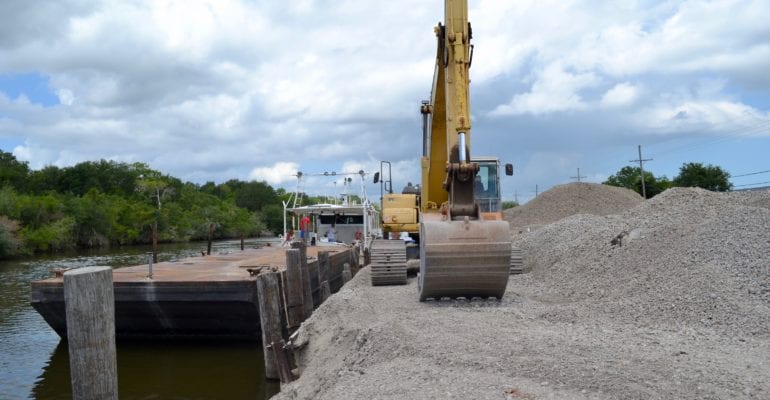The Louisiana Department of Wildlife and Fisheries (LDWF) has completed the construction of two oyster reefs totaling approximately 230 acres in Drum Bay (St. Bernard Parish) to increase oyster habitat and fisheries production. The construction process, known as cultch planting, is a proven habitat improvement technique used by LDWF.
This project was funded through Deepwater Horizon Natural Resource Damage Assessment (DWH NRDA) settlement dollars to restore for injuries to oysters that occurred as a result of the DWH spill. The Louisiana Trustee Implementation Group approved 26 million dollars in oyster projects, including enhancing oyster recovery using broodreefs, cultch-plant oyster restoration, and hatchery-based oyster restoration.
Since 1917, LDWF has placed over 1.5 million cubic yards of cultch material on nearly 30,000 acres with positive results. The 2022 Drum Bay cultch plant project spread 29,500 cubic yards of crushed limestone to create 230 acres of artificial oyster reef.
When placed in a suitable oyster habitat, cultch material provides a substrate for free-floating oyster larvae to attach and grow, resulting in a mature, productive oyster reef. Potential long-term benefits from increasing available cultch material include increased oyster production and oyster population connectivity, resilience, and stability. Healthy, interconnected oyster populations form reefs that provide the hard substrate needed for oyster larvae to settle, grow, and sustain the population. In addition to providing habitat for oysters, these reefs serve as habitat for various marine organisms, from small invertebrates to large recreationally and commercially important species. Furthermore, oyster reefs provide structural integrity, improve water quality, and potentially reduce coastal erosion.
Since 2010, the Public Oyster Grounds of the North Pontchartrain Basin have experienced multiple high mortality events. These have come as a result of strong tropical events such as Hurricane Isaac in 2012, Hurricane Nate in 2017, Hurricane Zeta in 2020, and Hurricane Ida in 2021; the Deepwater Horizon oil spill and related spill response activities; and devastating spring flood events prompting the opening of the Bonnet Carre Spillway. These continual limits to recruitment and survival have severely reduced oyster resources across the Pontchartrain Basin. Drum Bay was chosen due to its more remote location from any Mississippi River outflow and its higher resiliency to these recent stressors. According to the 2022 oyster stock assessment, areas of Drum Bay surrounding the newly constructed cultch plant contain roughly 20 percent of the total oyster resource of North Pontchartrain Basin Public Oyster Grounds. Due to its ability to maintain relatively stable conditions over the last few years, Drum Bay is the most suitable location to initiate renewed recovery efforts in the Pontchartrain Basin.
The cultch plant will be closed to recreational and commercial oyster harvest for at least two years to allow time for oyster recruitment and growth. LDWF will monitor the performance of the plant through regularly scheduled sampling events.
The Louisiana Department of Wildlife and Fisheries is charged with managing and protecting Louisiana’s abundant natural resources. For more information, visit us at www.wlf.la.gov. To receive LDWF email alerts, signup at http://www.wlf.la.gov/signup.





